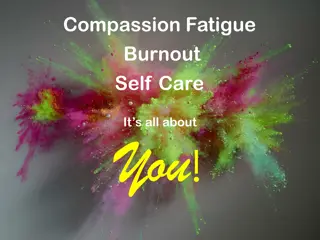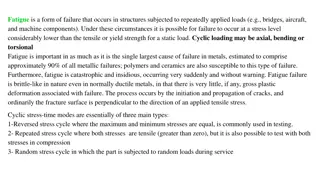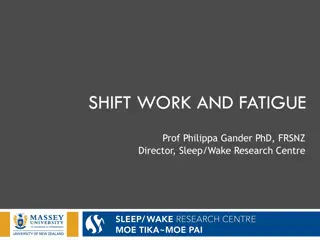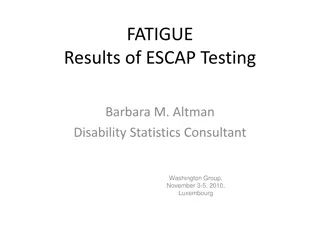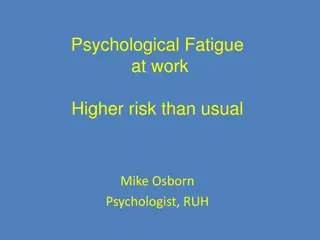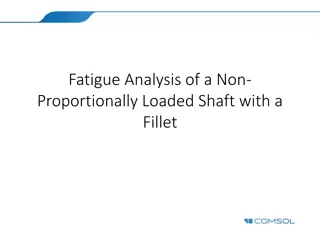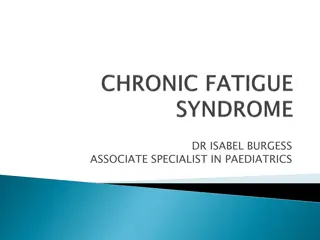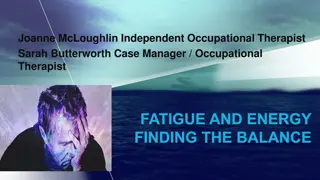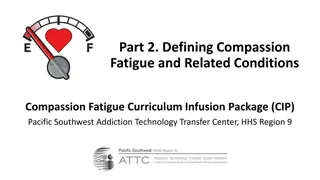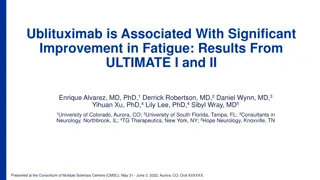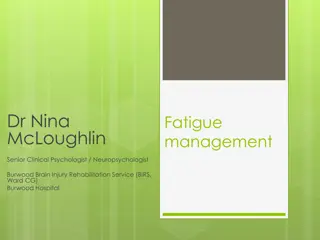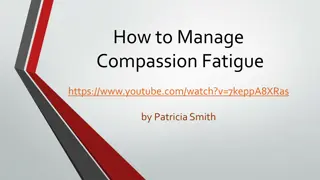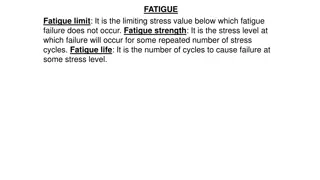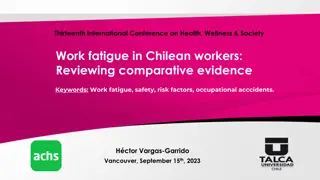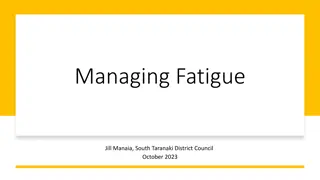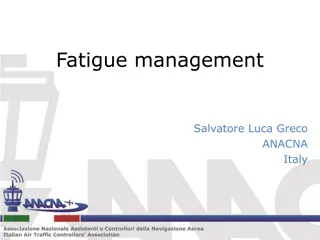Understanding Fatigue: Definitions, Causes, and Management
Fatigue is defined as an unpleasant symptom that affects an individual's normal functioning capacity. It can manifest as tiredness, weakness, or lack of energy. Common causes of fatigue include sleep loss, heavy physical or mental work, and chronic conditions like Chronic Fatigue Syndrome. The management of fatigue involves strategies such as adequate rest, relaxation, and lifestyle modifications. Fatigue can impact daily activities and quality of life, and it is important to address its underlying causes for effective management.
Download Presentation

Please find below an Image/Link to download the presentation.
The content on the website is provided AS IS for your information and personal use only. It may not be sold, licensed, or shared on other websites without obtaining consent from the author. Download presentation by click this link. If you encounter any issues during the download, it is possible that the publisher has removed the file from their server.
E N D
Presentation Transcript
Fatigue and Tiredness Dr. Abdualziz Alodhayani Associate Professor, FCM,KSU 2019
Fatigue and Tiredness Fatigue and Tiredness Definitions of fatigue Causes of fatigue Common symptoms and signs with fatigue Chronic Fatigue Syndrome Management of fatigue Summary.
Definitions Definitions Fatigue is an unpleasant symptom which interferes with individuals ability to function to their normal capacity. (Ream and Richardson, 1996) The European Association for Palliative: fatigue is a subjective feeling of tiredness, weakness or lack of energy. (Radbruch L et al ,2008)
o Tiredness is one of the most common complaints of people seen in primary healthcare. o Muscle tiredness (ASTHENIA)
EPIDEMIOLOGY OF FATIGUE EPIDEMIOLOGY OF FATIGUE oIt is one of the top 10 chief complaints leading to family practice oFatigue occurs in up to 20% of patients seeking care. oMore in women than in men. oPsychiatric illness is present in 60 to 80 % of patients with chronic fatigue.
FATIGUE. oRecent-Acute (less than one month), oProlonged-Subacute (more than one month till 6 months) oChronic (over six months)
Acute fatigue: Occurs within short duration. Its usually results sleep loss or from short periods of heavy physical or mental work. It can be reversed by sleep and relaxation. Chronic fatigue syndrome: It is the constant, severe state of tiredness that is not relieved by rest. It is similar to the flu, last longer than six months. It interferes with certain activities. The exact cause of this syndrome is still unknown.
Fatigue is two types Fatigue is two types Physical activities of daily living. prevents participation in activities and impedes Cognitive and thus prevents leisure activities complicates activities such as reading, driving a car
Fatigue symptoms Fatigue symptoms Difficulty or inability to initiate activity (subjective sense of weakness) Reduced capacity to maintain activity (easy fatigability) Difficulty with concentration, memory, and emotional stability (mental fatigue).
The impact of fatigue on quality of life. The impact of fatigue on quality of life. Fatigue has a strong negative impact on the patient s daily life. (Pederson, et al 2003)
Fatigue Consequences Fatigue Consequences
Effects of Fatigue Effects of Fatigue Reducing mental and physical functioning Impairing judgement and concentration, Lowering motivation, Slowing reaction time, and Increasing risk-taking behaviour.
EVALUATION OF FATIGUE EVALUATION OF FATIGUE History Physical examination Laboratory studies
EVALUATION OF FATIGUE EVALUATION OF FATIGUE It is subjective. There are no real tests for this with regard to traditional laboratory or imaging studies. It's a subjective lack of physical and/or mental energy that interferes with usual and desired activities.
History History Age, Gender, occupation abrupt or gradual, related to event or illness? Course stable, improving or worsening? Duration and daily pattern Factors that alleviate or exacerbate symptoms Impact on daily life -ability to work.
Physical examination Physical examination General appearance: level of alertness, psychomotor agitation or retardation, grooming (psychiatric disorder) Presence of lymphadenopathy: a possible sign of chronic infection or malignancy. Evidence of thyroid disease: goiter, thyroid nodule, ophthalmologic changes. Cardiopulmonary examination: signs of congestive heart failure and chronic lung disease. Neurologic examination: muscle bulk, tone, and strength; deep tendon reflexes..etc.
Laboratory tests Laboratory tests CBC with differentials. Chemistry screen (including electrolytes, glucose, renal and liver function tests). TSH Creatine kinase, if pain or muscle weakness present Other ???
Specific clinical signs of organic disease associated with Specific clinical signs of organic disease associated with fatigue fatigue Pallor, tachycardia, systolic ejection murmurs: anemia Blue sclera: iron deficiency. Jaundice, palmar erythema, Dupuytren's contracture: chronic liver disease Goiter or thyroid nodule, dry skin, delayed deep tendon reflexes, peri-orbital puffiness, ophthalmological changes: hypothyroidism Weight loss, hyper-reflexia, tachycardia, atrial fibrillation, fine tremor, goiter: hyperthyroidism Hypotension, pigmentation in skin creases, scars, and buccal mucosa: Addison's disease Pulmonary stasis, elevated jugular venous pressure, ankle edema: heart failure
Possible causes of Fatigue Possible causes of Fatigue Cancer Depression/emotional distress Insomnia Weight loss/poor nutrition/dehydration Infection Anemia Electrolyte imbalance Side effects of medication Co-morbidities
Treatment of Fatigue Treatment of Fatigue Role out: medical condition, a psychiatric condition, an inadequate sleep situation, a social situation, or a sleep disorder Nonpharmacologic and pharmacologic. Nonpharmacologic : - Patient education and understanding normal sleep requirements. - Diet and nutrition have a role; Pharmacological approach: stimulants, wake-promoting agents, and other drugs or treatments
Chronic Fatigue Syndrome (CFS) Chronic Fatigue Syndrome (CFS)
CHRONIC FATIGUE SYNDROME CHRONIC FATIGUE SYNDROME 1. Unexplained, persistent or relapsing fatigue: that is of new onset; is not the result of ongoing exertion; is not alleviated by rest; and results in substantial reduction in previous levels of occupational, educational, social, or personal activities and 2. Four or more of the following: that persist or recur during six months. Self-reported short term memory impairment , Sore throat, Tender cervical or axillary nodes, Muscle pain, Multi-joint pain without redness or swelling, Headaches of a new pattern or severity, Unrefreshing sleep, Post-exertional malaise lasting 24 hour
History OF CFS Typically report postexertional fatigue and feeling excessively tired after relatively normal tasks Patients also report fatigue even after prolonged periods of rest or sleep. Typically report problems with short-term memory They may report verbal dyslexia as the inability to find particular word during normal speech. The five main symptoms: Reduction or impairment in ability to carry out normal daily activities, accompanied by profound fatigue Postexertional malaise (worsening of symptoms after physical, cognitive, or emotional effort) Unrefreshing sleep Cognitive impairment Orthostatic intolerance (symptoms that worsen when a person stands upright and improve when the person lies back down)
Percentage of the common symptoms of patients Percentage of the common symptoms of patients Easy fatiguability 100 % Difficulty concentrating 90% Headache 90 % Sore throat 85 % Tender lymph nodes 80 % Muscle aches 80 % Joint aches 75 % Feverishness 75 %
Physical Examination Physical examination often reveals no abnormalities. Some patients may have positive orthostatic vital signs. Many patients have small, moveable, painless lymph nodes that most commonly involve the neck, axillary region, or inguinal region
Possible causes: Possible causes: oIdiopathic oInfection Epstein-Barr virus (EBV) oDepression oSleep disruption oOthers
TREATMENT TREATMENT The doctor-patient relationship Establishing therapeutic goals. Accomplishing the activities of daily living. Returning to work. Maintaining interpersonal relationships. Performing some form of daily exercise. Brief regularly scheduled appointments.
CFS Treatment CFS Treatment Approach Considerations CFS has no cure. Treatment is largely supportive and focuses on symptom relief. Cognitive Behavioral Therapy (CBT).
Exercise Therapy Exercise is not a cure for CFS. The patients felt less fatigued following exercise therapy and felt improved in terms of sleep, physical function, and general health. (A 2017 Cochrane review) Graded Exercise Therapy (GET) is not recommended. (The CDC and AHRQ)







